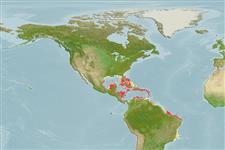>
Eupercaria/misc (Various families in series Eupercaria) >
Labridae (Wrasses) > Xyrichtyinae
Etymology: Xyrichtys: Greek, xyreo = that cuts like a knife + Greek, ichthys = fish (Ref. 45335).
More on author: Valenciennes.
Environment: milieu / climate zone / depth range / distribution range
Ecologia
marinhas associadas(os) a recifes; intervalo de profundidade 2 - 21 m (Ref. 7251). Subtropical
Western Atlantic: southern Florida, USA and Bahamas to northern South America.
Tamanho / Peso / Idade
Maturity: Lm ? range ? - ? cm
Max length : 15.0 cm TL macho/indeterminado; (Ref. 7251)
Descrição breve
Morfologia | Morfometria
Females light greenish gray, becoming pinkish ventrally, with diffuse orange-red stripe from behind eye to base of caudal fin; a broad white area over abdomen, the lower part with vertical lines of red; there may be faint red bars on the body. Large adult males lose the distinctive red, white and black markings; they develop a vertically elongate blue spot on each body scale; a yellow head with near-vertical pale blue bands, and a large dark spot in axil of pectoral fins (Ref. 13442).
Most common in open sandy areas. Feeds on small sand-dwelling invertebrates. Dives head first into the sand when frightened. Generally common (Ref. 9710). Generally of no interest to fisheries because of its small average size (Ref. 5217).
Life cycle and mating behavior
Maturidade | Reprodução | Desova | Ovos | Fecundidade | Larvas
Robins, C.R. and G.C. Ray, 1986. A field guide to Atlantic coast fishes of North America. Houghton Mifflin Company, Boston, U.S.A. 354 p. (Ref. 7251)
Categoria na Lista Vermelha da IUCN (Ref. 130435)
Ameaça para o homem
Harmless
Utilização humana
Aquário: Espécies comerciais
Mais informação
Nomes comunsSinónimosMetabolismoPredadoresEcotoxicologiaReproduçãoMaturidadeDesovaAgregação para desovaFecundidadeOvosDesenvolvimento dos ovos
ReferênciasAquaculturaPerfil para aquaculturaEstirpesGenéticaElectrophoresesHereditariedadeDoençasProcessamentoNutrientsMass conversion
ColaboradoresFotografiasStamps, Coins Misc.SonsCiguateraVelocidadeTipo de nataçãoÁrea branquialOutras referênciasCérebrosVisão
Ferramentas
Relatórios especiais
Descarregue XML
Fontes da internet
Estimates based on models
Preferred temperature (Ref.
123201): 25.1 - 28.2, mean 27.4 °C (based on 619 cells).
Phylogenetic diversity index (Ref.
82804): PD
50 = 0.5005 [Uniqueness, from 0.5 = low to 2.0 = high].
Bayesian length-weight: a=0.00676 (0.00275 - 0.01660), b=3.05 (2.84 - 3.26), in cm total length, based on LWR estimates for this (Sub)family-body shape (Ref.
93245).
Nível Trófico (Ref.
69278): 3.5 ±0.37 se; based on food items.
Resiliência (Ref.
120179): Elevada, tempo mínimo de duplicação da população menor que 15 meses (Preliminary K or Fecundity.).
Fishing Vulnerability (Ref.
59153): Low vulnerability (10 of 100).
Nutrients (Ref.
124155): Calcium = 65.3 [27.2, 142.0] mg/100g; Iron = 0.678 [0.355, 1.489] mg/100g; Protein = 18.7 [15.8, 21.0] %; Omega3 = 0.147 [0.074, 0.285] g/100g; Selenium = 11.4 [4.8, 27.1] μg/100g; VitaminA = 85.4 [22.3, 426.5] μg/100g; Zinc = 1.19 [0.69, 2.13] mg/100g (wet weight);
